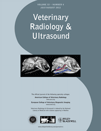ULTRASONOGRAPHIC ASSESSMENT OF ABDOMINAL LYMPH NODES IN PUPPIES
Abstract
The jejunal and medial iliac lymph nodes of 53 clinically normal dogs between the age of 4 and 6 weeks were examined ultrasonographically. At least two jejunal and both left and right medial iliac lymph nodes were seen in all dogs. One hundred forty-five jejunal, 53 right medial iliac and 53 left medial iliac lymph nodes in six litters of dogs, for a total of 251 lymph nodes, were measured for cross sectional maximum diameters. Mean jejunal lymph node length was 16.4 mm (range 6.4–34.9 mm) and mean width was 6.0 mm (range 2.3–15.7 mm). The mean medial iliac lymph node length was 13.6 mm (range 7.2–27.8 mm) and mean width was 4.4 mm (range 1.9–8.2 mm). Significant differences of lymph node size, noted between and within breeds, may not be of clinical significance. The mean size of the combined left and right medial iliac nodes was within previously published ranges for normal adult dogs. Lymph nodes were described in four litters of dogs (162 lymph nodes). Lymph nodes were either uniformly hypoechoic (108/163, 66%) or centrally hyperechoic with a hypoechoic rim (55/163, 34%). Although most (60%) lymph nodes were oval, a variety of shapes were seen, including vermiform and complex branching shapes. We concluded that in 4- to 6-week-old dogs, medial iliac lymph nodes are similar in size to adult dogs and jejunal lymph nodes are multiple, routinely seen, are larger than in adults and often have unconventional shapes.
Introduction
here is limited information regarding the characteristics of abdominal lymph nodes in normal neonatal dogs. It was our opinion that jejunal lymph nodes in neonatal dogs were subjectively easier to identify and larger than in adults. Our purpose was to document the ultrasonographic appearance of abdominal lymph nodes in clinically normal very young dogs. Our specific objectives were to measure jejunal and medial iliac abdominal lymph nodes and describe echogenicity and shapes of the nodes in neonatal dogs.
Materials and Methods
The population consisted of clinically normal purebred puppies brought in by breeders who volunteered for the ultrasound exams. Fifty-three dogs from six litters were imaged. There were golden retriever (two litters, 15 dogs), collie (two litters, 19 dogs), bloodhound (8 dogs), and standard poodle (11 dogs) breeds. There were 28 males and 25 females and all were between 4 and 6 weeks of age. The puppies had been on a strict deworming schedule and there was no evidence of systemic abnormalities for at least 7 days before and 2 weeks after the study.
A linear transducer (8–16 MHz) was used.1,2 Dogs were not sedated for imaging. Isopropyl alcohol (70%) applied to the unclipped skin provided consistently excellent image quality without clipping. Patient compliance was limited in all animals, limiting the scan time to approximately one minute and the evaluation of only jejunal and medial iliac lymph nodes. Dogs were initially imaged in dorsal recumbency and jejunal lymph nodes were identified adjacent to the cranial mesenteric artery and vein. Dogs were then repositioned in left then right recumbency to image the nondependent medial iliac lymph nodes.
Lymph nodes were imaged individually in multiple planes by a board certified radiologist and measurements of maximum length and width were obtained. Mean measurements were evaluated using a two-tailed unpaired Student's t-test with Welch's correction for unequal variances. Significance was set at P < 0.05.
Images were not available for postimaging review in 19 of the 53 dogs, because of limitation of the portable system used initially. In the remaining 34 dogs, ultrasonographic images of each lymph node were classified into one of three shapes: ovoid, vermiform, and miscellaneous (Fig. 1). Lymph nodes were considered miscellaneous in shape if they could not be put clearly into one of the other two categories. This included lymph nodes with odd three-dimensional patterns, multiple branching-shaped, or whorls (Fig. 2). Echogenicity was also assessed.


Results
All lymph nodes were identified easily and 251 were measured. A minimum of two jejunal lymph nodes was identified in all puppies. More than three was difficult to verify and three was considered the maximum number of jejunal lymph nodes that could be identified with confidence. Overall mean jejunal and medial iliac lymph node length and width are presented in Table 1. The range of size measurements of both medial iliac (length: 5.4–27.8 mm, width: 1.9–8.2 mm) and jejunal (length: 6.4–34.9 mm, width: 2.3–15.7 mm) lymph nodes was high.
| Length (Range) (mm) | Width (Range) (mm) | |
|---|---|---|
| Jejunal | 16.41 (6.4–34.9) | 6.02 (2.3–15.7) |
| Medial Iliac (all) | 13.61 (5.4–27.8) | 4.37 (1.9–8.2) |
| R Medial Iliac | 14.28 (7.2–27.8) | 4.28 (2.2–7.9) |
| L Medial Iliac | 12.93 (5.4–23.3) | 4.46 (1.9–8.2) |
Jejunal lymph node length was compared as a function of breed (Table 2). Jejunal lymph nodes in the standard poodle were significantly shorter than in all other breeds. Additionally, golden retrievers and bloodhounds had longer jejunal lymph nodes than collies. Standard poodles had shorter right medial iliac lymph nodes than in all other breeds and narrower left medial iliac lymph nodes than golden retrievers or bloodhounds. Collies had narrower right medial iliac lymph nodes than golden retrievers or bloodhounds. Bloodhounds had shorter left medial iliac lymph nodes than in all other breeds.
| Collie | Golden Retriever | Bloodhound | Standard Poodle | |||||
|---|---|---|---|---|---|---|---|---|
| n | Mean (SD) | n | Mean (SD) | n | Mean (SD) | n | Mean (SD) | |
| Jejunal length | 56 | 15.2 (2.0)a | 835 | 19.8 (5.7)ab | 23 | 18.8 (7.2)ab | 31 | 12.9 (3.5)b |
| Jejunal width | 5.7 (1.0) | 7.5 (3.8)a | 6.6 (2.2) | 4.8 (1.1) | ||||
| R medial iliac length | 19 | 14.6 (4.6)a | 15 | 15.9 (5.0)a | 8 | 15.7 (3.9)a | 11 | 10.6 (2.2) |
| R medial iliac width | 3.7 (0.8) | 5.0 (1.6)b | 4.7 (1.0)b | 4.0 (0.7) | ||||
| L medial iliac length | 19 | 12.2 (1.1)c | 15 | 14.1 (6.6)c | 8 | 9.5 (0.5) | 11 | 15.1 (1.0)c |
| L medial iliac width | 4.0 (1.2) | 5.5 (1.5)a | 4.7 (0.4)a | 3.7 (0.8) | ||||
- n, number of lymph nodes measured; Mean, mean distance in millimeters; SD, standard deviation in millimeters; L, left; R, right.
- a Significant difference (P < 0.05) in size compared to standard poodle puppies.
- b Significant difference (P < 0.05) in size compared to collie puppies.
- c Significant difference (P < 0.05) in size compared to blood hound puppies.
Lymph node size was compared between two different litters of golden retrievers and collies (Table 3). Significant differences were present between mean length and width of jejunal and pooled right and left medial iliac nodes in the two litters of golden retrievers. The only difference between the two litters of collies was the width of the pooled medial iliac lymph nodes. Lymph node size was also compared as a function of gender and a statistically significant difference was not found.
| Golden Retriever A | Golden Retriever B | Collie A | Collie B | |
|---|---|---|---|---|
| Mean (mm) (standard deviation) | ||||
| Jejunal length | 21.5 (4.8)a | 18.3 (4.9)a | 16.3 (4.2) | 14.1 (4.3) |
| Jejunal width | 8.5 (2.8)a | 5.1 (1.8)a | 6.5 (1.7) | 5.22 (1.8) |
| Medial Iliac length | 19.7 (3.0)a | 9.6 (2.7)a | 12.8 (2.6) | 13.9 (3.8) |
| Medial Iliac width | 6.1 (1.4)a | 4.3 (0.3)a | 3.3 (0.9)a | 4.1 (1.0)a |
- a Significant (P < 0.05) different between litters of same breed.
Lymph node shape was assessed in the 34 dogs where images were archived. Ninety-seven of 163 lymph nodes (60%) were ovoid. The medial iliac nodes were most commonly (53/68, 78%) ovoid whereas jejunal lymph nodes were less commonly ovoid (44/95, 46%) (Table 4).
| Ovoid | Elongated | Miscellaneous | |
|---|---|---|---|
| Jejunal | 44 | 22 | 29 |
| R Medial Iliac | 25 | 9 | 0 |
| L Medial Iliac | 28 | 6 | 0 |
- Number indicates number of lymph nodes having that shape. R, right; L, left.
The only two distinct patterns of echogenicity found were uniformly hypoechoic, and hyperechoic center with variable thickness of distinctly hypoechoic rim. Of the 163 lymph nodes assessed, 108 (or 66%) were uniformly hypoechoic.
Images from two unrelated litters of collies were analyzed for shape (Table 5). In one, 14 of 29 (48%) jejunal lymph nodes were miscellaneous in shape in the other only 6 of 26 (23%) were miscellaneous in shape. In both litters, medial iliac lymph nodes tended to be ovoid, as was true for all breeds evaluated (Table 5).
| Collie Litter A | Collie Litter B | |||||
|---|---|---|---|---|---|---|
| R Medial | L Medial | R Medial | L Medial | |||
| Jejunal | Iliac | Iliac | Jejunal | Iliac | Iliac | |
| Ovoid | 9 | 5 | 7 | 15 | 6 | 8 |
| Vermiform | 6 | 5 | 3 | 5 | 3 | 1 |
| Miscellaneous | 14 | 0 | 0 | 6 | 0 | 0 |
- Number indicates number of lymph nodes having that shape. R, right; L, left.
Discussion
The width and thickness, but not length, of jejunal lymph nodes in clinically normal dogs has been assessed previously but the exact age and number of dogs less than one year of age were not provided. 6 In that evaluation, three jejunal lymph nodes were found in only 1 of 57 dogs, compared with 39 of 53 dogs in the current study, although the effect of age on the number of lymph nodes detected was not discussed. The width and thickness of jejunal lymph nodes was associated inversely with age but specific values for dogs <1 year of age were not provided. It was concluded that lymph nodes were thicker in young dogs. Length and width of the medial iliac lymph nodes were also quantified and they did not exceed previously published values.4, 5 Additionally, there was no difference in size between right and left medial iliac lymph nodes, which also agrees with prior reports.4, 5 These findings suggest there is less variation in size of the medial iliac nodes as a function of age than with jejunal lymph nodes.
It has been stated that lymph node size in young animals decreases with age but no data were provided.8 The larger lymph node size in young animals was attributed to antigenic stimuli. Based on our results, it is reasonable to assume that the lymph node sizes we documented represent the norm for clinically normal puppies.
We have insufficient data to reach a conclusion on association between breed and abdominal lymph node size, but it is of interest that some differences were litter related rather than breed related. For example, the two litters of golden retrievers had significant differences in every measured dimension of all lymph nodes. This difference could have a genetic or environmental basis, such as with different housing conditions (indoor versus outdoors), seasonality, or disease status of other dogs in the kennel.
All abdominal lymph nodes that we assessed were either hypoechoic to surrounding tissue, or centrally hyperechoic with a hypoechoic rim. Previously, in dogs <2 years of age, lymph nodes were documented to usually be centrally hyperechoic with a hypoechoic rim but with age the lymph nodes became isoechoic.6 Uniform hypoechogenicity and enlarged size in adult dogs is generally considered abnormal.2-4
It is important to reiterate that in this study all measurements were made with the lymph nodes captured in long axis positions that allowed for the best visualization of length and width. No node was analyzed in the short
axis for assessment of thickness. Thus, measurements did not account for the portion of the node that was not visualized and therefore may be not represent the overall size and shape accurately. Our objective was to quantify jejunal and medial iliac lymph node size in normal dogs 4–6 weeks of age. Based on our evaluation, jejunal lymph nodes in healthy puppies are larger than in adult dogs, can be either hypoechoic or heteroechoic, and may have an unusual shape. Breed may be a determining factor regarding lymph node size and shape.




